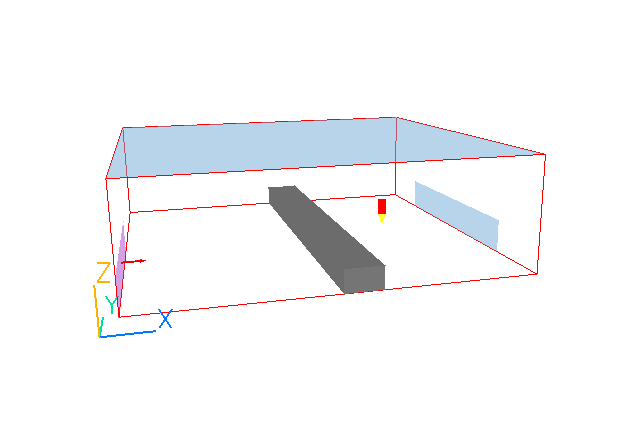
This workshop example shows how to set up and run the simulation of 3D transient free surface flow of water in air by the Volume-Of-Fluid (VOF) Model in PHOENICS-VR.
The task is to simulate the water pouring into a bund through the bottom slot at the right side wall. The opposite side wall has an opening through which the water leaks out of the bund. Internal obstacle is located on the water path.
It is expected that the water starts to propagate into the bund along the horizontal floor until it encounters the internal beam. It re-directs the water stream until it finally reaches the leak opening over-flowing the obstacle.
The geometry is shown in the figure below.

From the system level:
To enter the PHOENICS-VR environment, click on the PHOENICS icon on the desktop, or click on Start, programs, PHOENICS, PHOENICS.
In PHOENICS-VR environment,
Start with an 'empty' case - click on 'File' then on 'Start New Case', then on 'Core', then click on 'OK'; to confirm the resetting.
To enter VR Editor:
This is the default mode of operation .
Set the domain size, and activate solution of the required variables:
Click on 'Menu' and set 'Water pouring into a bund
Click on 'Geometry'.
Change the Z-Domain Size to 0.3 m.
Click on Time dependence STEADY to toggle to TRANSIENT.
Click on 'Time step settings'.
Set:
- Starting time: 0.0
- Duration: 1.0
- Number of steps: 1000
Click 'OK' to close the Time step settings dialog, then 'OK' to close the Grid mesh settings dialog.
Click on 'Models'.
Leave the 'Solution for velocities and pressure' ON.
Set the 'Free-surface model' to VOF-CICSAM.
Leave settings for cut-off values for interface sharpening as default 0.001 and 0.999.
Leave the surface tension as 0.0.
Specify properties
Click on 'Properties'.
Leave the default settings for the 'light fluid' and the 'heavy fluid' they are '0 Air at 20 C deg, 1 atm' and '67 Water at 20 deg C' respectively.
Click on Property 'Storage' and set 'ON' for Density and Viscosity, then on 'Previous panel'.
Keep the default setting for Domain initially full of: Light fluid
Click on 'Top menu' to return to the top menu.
Click on 'OK' to exit the Main Menu.
Click on 'Reset' and then on 'Fit to window'/'OK'.
Create the BEAM object:
Click on 'Settings', 'New', 'New Object', 'Blockage' on the top bar menu.
Change name to BEAM.
Click on 'Size' and set SIZE of object as:
Xsize: 0.1
Ysize: 'To end'
Zsize: 0.06
Click on 'Place' and set POSITION of object as:
Xpos: 0.5
Ypos: 0.0
Zpos: 0.0
and on 'OK' to close the Object Specification Dialogue Box.
Create the WATER-IN object:
Click on 'Settings', 'New', 'New Object', 'Inlet' on the top bar menu. Select the X plane for the inlet to lie in.
Change name to WATER-IN.
Click on 'Size' and set SIZE of object as:
Xsize: 0.0
Ysize: 0.5
Zsize: 0.09
Click on 'General'.
Click on 'Attributes' and set velocity in X-direction at 5.0 m/s.
Set 'Inlet density' at 'Heavy' for the inflowing water.
Click on 'OK' to close the Attributes menu,
and on 'OK' in the Object Dialogue Box.
Create the OUTLET object:
Click on 'Settings', 'New', 'New Object', 'Outlet' on the top bar menu. Select the X plane for the outlet to lie in.
Change name to OUTLET.
Click on 'Size' and set SIZE of object as:
Xsize: 0.0
Ysize: 0.6
Zsize: 0.09
Click on 'Place' and set POSITION of object as:
Xpos: 'At end'
Ypos: 0.2
Zpos: 0.0
Click on 'General'.
Leave the default values in the Attributes dialogue box.
Click on 'OK' to exit the Object Dialogue Box.
Create the FREE-TOP object:
Click on 'Settings', 'New', 'New Object', 'Outlet' on the top bar menu. select the Z plane for the outlet to lie in.
Change name to FREE-TOP.
Click on 'Size' and set SIZE of object as:
Xsize: 'To end'
Ysize: 'To end'
Zsize: 0.0
Click on 'Place' and set POSITION of object as:
Xpos: 0.0
Ypos: 0.0
Zpos: 'At end'
Click on 'General'.
Leave the default values in the Attributes dialogue box.
Click on 'OK' to exit the Object Specification Dialogue Box.
Set gravity:
Click on 'Main Menu'
Click on 'Sources'.
Set 'Gravitational forces' ON and 'OK'.
Set 'Buoyancy model' to CONSTANT
Change 'Gravitational acceleration' to 0.0 in X and Y directions and -9.81 in Z.
Set the remaining solution-output-control parameters:
Click on 'Numerics'.
Set the number of iterations to 20.
Click on 'Output'.
Go into 'Field dumping' settings.
Turn 'Intermediate field dumps' ON.
Change 'Step frequency' to 10.
Change 'Start letter for solution file' to N
Click on 'Previous panel'.
Click on 'Top menu' to return to the top menu.
Click on 'OK' to exit the Main Menu.
Setting the Grid
Click the mesh toggle
to display the grid. The orange lines are region boundaries, located at the edges of the objects. The blue lines are 'ordinary' grid lines inserted by the auto-mesher. In this case, the default grid in X (47 cells).Y (52 cells) and Z (44 cells) is too fine for the tutorial, as the case would take too long to run.
We will take the opportunity to practice setting the grid manually.
Click 'Edit all regions in X direction'. Turn the auto grid settings to Off. Set the cell numbers in each region as follows:
X direction Region 1 = 14, Region 2=3, Region 3=4, Region 4=11
Click 'Edit all regions in Y direction'. Turn the auto grid settings to Off. Set the cell numbers in each region as follows:
Y direction Region 1 = 2, Region 2=4, Region 3=2
Click 'Edit all regions in Z direction'. Turn the auto grid settings to Off. Set the cell numbers in each region as follows:
Z direction Region 1 = 3, Region 2=2, Region 3=12
Click on 'OK' to close the Grid mesh settings dialog.
Setting the Probe Location
Before running the solver,it is a good idea to place the probe in a suitable place to monitor the convergence of the solution. Too close to an inlet, and the value will settle down very quickly before the rest of the solution. Placed in a recirculation zone, it may still show traces of change even though the bulk solution is converged. In this case, somewhere downstream of the beam is fine.
Click on the probe icon
on the toolbar or double-click the probe itself, and move the probe to X=0.75, Y=0.5, Z=0.03.
In the PHOENICS-VR environment, click on 'Run', 'Solver'(Earth), and click on 'Yes' to confirm running the Solver.
In the PHOENICS-VR environment, click on 'Run', 'Post processor', then GUI Post processor (VR Viewer).
Click on 'Use intermediate step files'/'OK'.
Click on 'C' (select a variable) button, and select VFOL.
Click on 'Run animation' button to display the results.
A few selected plots at various time steps are shown below.
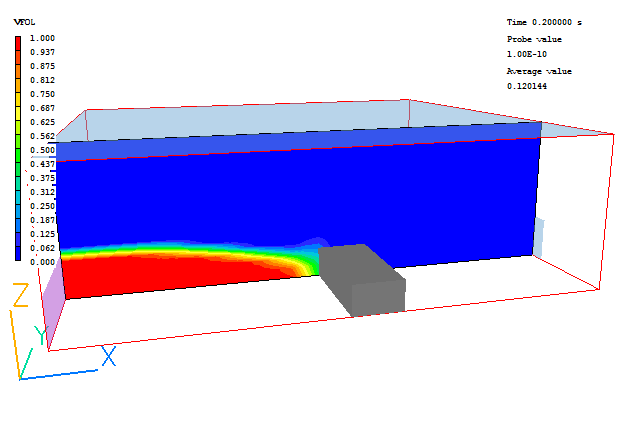 |
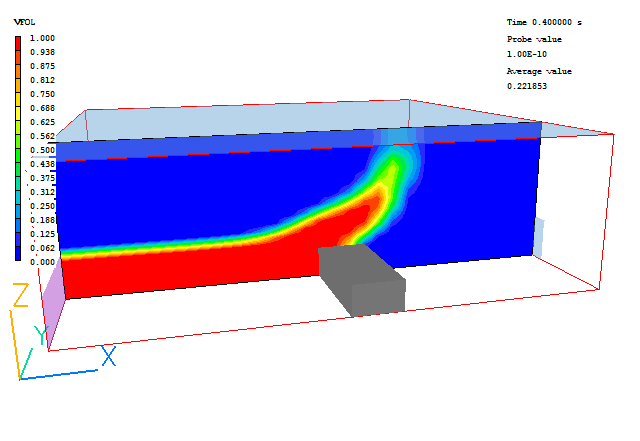 |
Time = 0.1 s |
Time = 0.3 s |
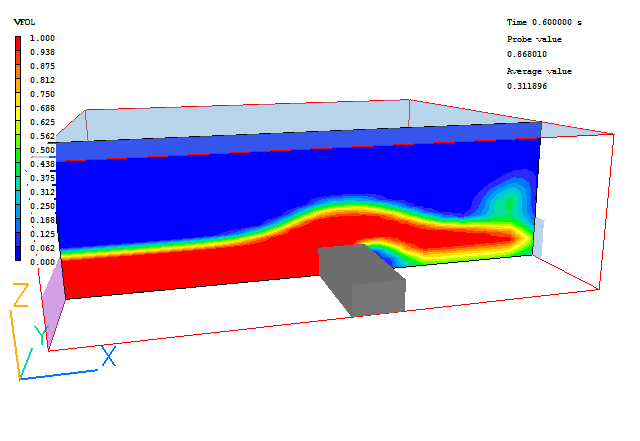 |
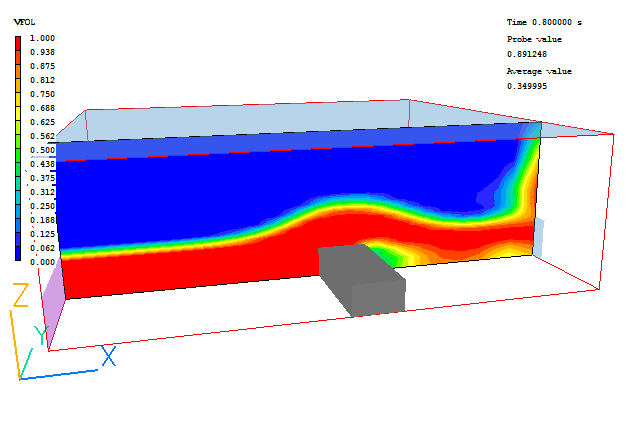 |
| Time = 0.6 | Time = 0.8 |
In the PHOENICS-VR environment, click on 'Save as a case', make a new folder called 'BUND ' (e.g.) and save as 'CASE1' (e.g.).